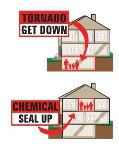The ability to take shelter is critical in times of emergency and disaster. Depending on your circumstances and the nature of the disaster, It may be best to stay where you are and avoid any uncertainty outside by "sheltering in place". Circumstances may also dictate sheltering outside the hazard area whether its with friends and relatives, seeking commercial lodging or staying in a mass care facility.
Fallout Shelters
Mass Care Shelter
These type tacilities are temporary public living quarters that provide physical shelter, feeding, first aid and basic sanitary facilities. This type of shelter does not provide specialized medical care. Each sheltering situation can be unique, depending on the emergency.
Mass care facilities involves sheltering with many people in a confined space, which can be challenging and unpleasant in the best of times, and amplified during the stress of a disaster or emergency. Alcoholic beverages and weapons are forbidden in emergency shelters and smoking is restricted. You may want to take your disaster kit with you to supplement any aid you may recieve at the shelter.
The Federal Emergency Management Agency (FEMA) offers a search for open shelters by texting SHELTER and a Zip Code to 43362 (4FEMA).
Shelter in place
Shelter in place usually means to take refuge in a small interior room with few or no windows. Typically it is in response to hazardeous material events such as when chemical, biological or radiological contaminations are released. Extreme weather and civil unrest may also warrant the use of these type shelters.
Once you have sheltered in, monitor communications from local authorities or public media outlets for further instructions. Advise your emergency contact of the situation, where you are and what phone you are using.
Be prepared to evacuate if ordered to do so. If evacuation orders are issued you will be given instructions on how to proceed. You should remain sheltered in place until evacuation orders are issued or a all-clear message in received.
Because of the dangers of smoke, carbon monoxide and limited oxygen supply. Do NOT burn anything for heat or light in the shelter. The amount of oxygen available in a shelter and time it can be inhabitated is directly dependent on the size of the space, the amount of occupants and amount of activity inside the shelter. Ideally all occupants will occupy the shelter before exposure can occur, in the event contamination is suspected, the victim should remove all clothes (dry-decontamination) before entering. A proper disaster kit should contain a set of clothes for the victim.
Safe Room
A safe room is a hardened structure specifically designed to meet the Federal Emergency Management Agency (FEMA) criteria and provide "near-absolute protection" in extreme weather events. Safe rooms are typically constructed from reinforced concrete, steel or other strong materials. They are usually built in a basement, on a garage floor, on a slab-grade foundation or an interior room on the lowest floor. The room is anchored to prevent overturning.
FEMA offers FEMA P-320, Taking Shelter From the Storm a publication to help home or small business owners assess their risk and determine the best type of safe room for their needs. The publication provides designs for basement, in-ground, and above-ground safe rooms.



